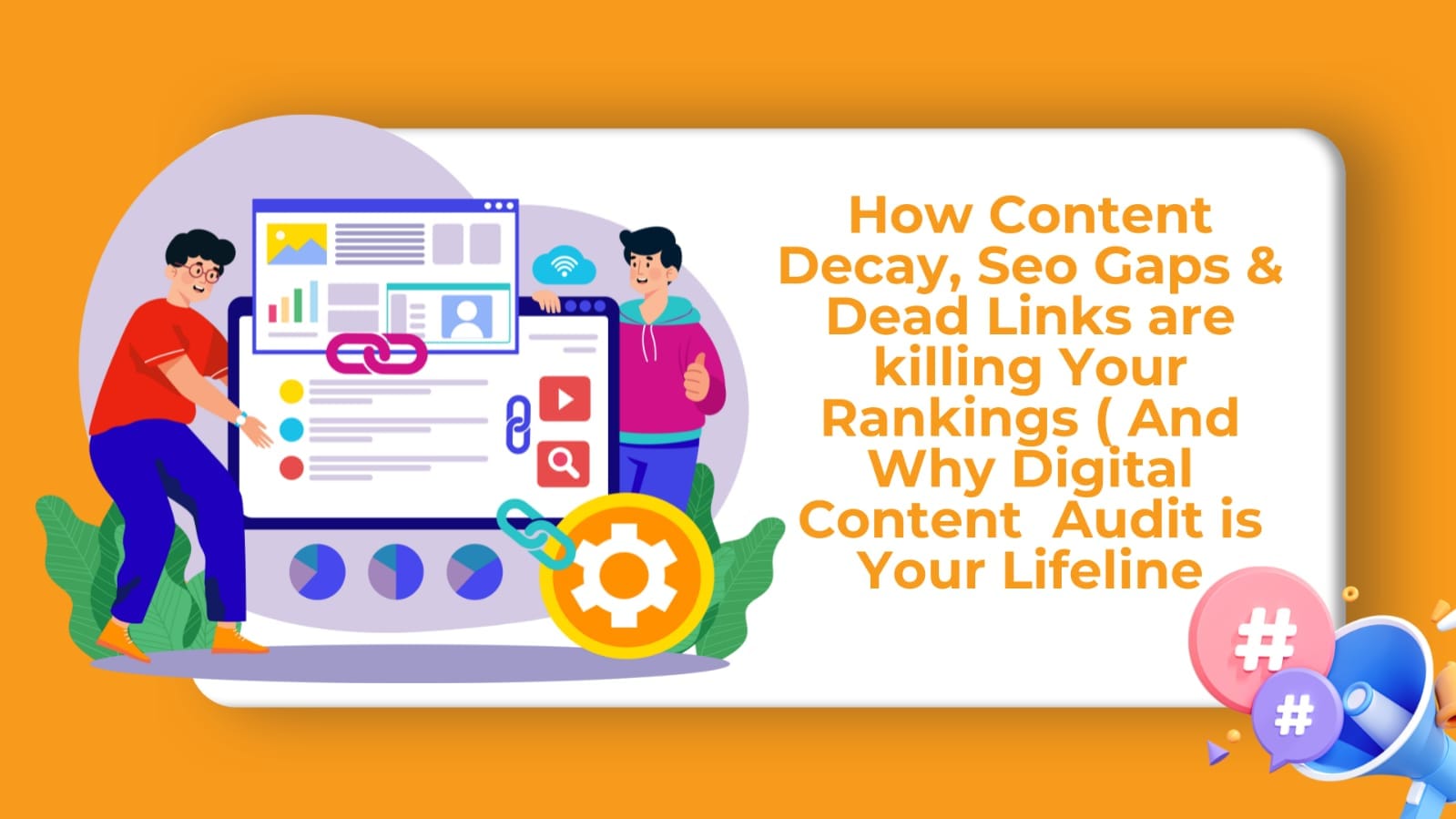Table of Contents
Introduction
Is your website’s performance mysteriously declining despite publishing new content regularly? If so, your digital content audit strategy might have a hidden problem—your older content. Content decay, SEO content gap analysis, and broken web links are often to blame for falling traffic, poor rankings, and reduced user engagement.
The solution? A digital content audit—your secret weapon for reviving old content, plugging SEO gaps, and restoring your online visibility.
Let’s explore why auditing your existing content is no longer optional—it’s urgent.
What Is Content Decay (and Why Should You Care)?
Content decay refers to the slow decline in organic traffic to previously high-performing blog posts or pages. Even the best content can become outdated or irrelevant as algorithms change and competitors publish newer, optimized alternatives.
Common signs of content decay:
- Falling search rankings
- Drop in traffic over time
- Fewer backlinks
- Reduced engagement or time on page
Ignoring content decay not only hurts your content strategy roadmap, but also wastes the potential of high-effort posts that could still bring in leads—if updated correctly.
What Is a Digital Content Audit?
A digital content audit is the process of evaluating all your published web content to determine its current value, SEO health, and performance. It identifies outdated information, SEO content gaps, and broken web links that may be harming your site’s authority and visibility.
Why it’s essential:
- Fixes underperforming content
- Closes SEO gaps
- Enhances user experience
- Maximizes ROI from old posts
Pro Tip: Add this to your regular content strategy roadmap to stay ahead of competitors in 2025 and beyond.

Step-by-Step: How to Perform a Digital Content Audit
✅Use tools like Screaming Frog, Ahrefs, or Semrush to crawl your website and extract all indexed pages.
✅Measure:
- Last updated date
- Organic traffic
- Keyword positions
- Backlinks
- Bounce rate
- Time on page
✅Label each page:
- Remove (irrelevant or thin content)
- Keep (performing well)
- Update (has potential but needs work)
- Merge (duplicate or related content)
✅Use tools like Semrush’s Keyword Gap or Ahrefs’ Content Gap to find keywords your competitors are ranking for—but you aren’t. Look for:
- Content structure gaps
- Untapped longtail keywords
- Questions from Google’s “People Also Ask”
✅Refresh outdated information
- Add relevant keywords and headings
- Improve readability and formatting
- Add multimedia or internal links
Use a broken link checker tool to find and replace or remove all non-working URLs. This simple fix can quickly boost trust and SEO rankings.
Document all changes made and include the page in your content calendar for future updates. This ensures continuous optimization and traffic growth.
The Role of SEO Content Gap Analysis
Even well-written content can miss the mark if it doesn’t align with current search intent or evolving keyword trends. SEO content gap analysis helps you uncover opportunities you’re currently missing.
Here’s what it reveals:
- Keywords competitors rank for, but you don’t
- Missing subtopics or questions users ask
- Poorly optimized meta tags and headers
- Unaddressed longtail search queries
Incorporating these findings into your content strategy roadmap ensures your site content remains relevant, discoverable, and valuable.
Why Broken Web Links Are a Big Deal
Broken links and SEO don’t mix. Broken web links—whether internal or external—create a poor user experience and signal to search engines that your site is poorly maintained.
Broken links lead to:
- Increased bounce rates
- Reduced crawlability
- Lost link equity
- Penalties in search engine algorithms
Every time a user clicks a dead link and lands on a 404 error, it damages trust and weakens your SEO foundation.with A detailed digital marketing audit ensures that your investment pays off across all fronts.
Digital Audit as a Strategic Tool
Rather than seeing an audit as a checklist or technical formality, forward-thinking brands treat it as a strategic compass. It tells you:
- Where to focus time and money during redesign
- Which content to revamp vs. retire
- What technical issues are dragging down performance
- How to craft messaging that better resonates with your audience
The goal isn’t just to have a “new look.” It’s to humanize the brand’s digital experience — something that can’t happen without first understanding the story your data tells.nections. Personalize experiences. Add human touches to automation. Show up with value, not just volume.
When Should You Conduct a Digital Content Audit?
Perform an audit at least twice a year, or immediately if you notice:
- Sharp decline in organic traffic
- Drop in keyword rankings
- Spike in bounce rate
- Multiple 404 errors or broken links
Final Thoughts: Don’t Let Old Content Hold You Back
Your website is a digital asset—but only if it’s well maintained. Content decay, SEO content gap issues, and broken links silently erode your site’s authority and user trust.
A digital content audit helps you:
- Fix what’s broken
- Discover what’s missing
- Maximize what’s already working
Build this practice into your content strategy roadmap and you’ll see higher engagement, improved SEO performance, and stronger lead generation over time.
Book your free digital marketing audit today.
Stay updated with SunBPO Solutions for the latest trends, insights, and strategies to keep your business ahead of the curve!
Frequently Asked Questions (FAQs)
Why is content decay a problem for SEO?
Content decay leads to a gradual decline in search rankings and organic traffic. This happens when content becomes outdated, irrelevant, or overshadowed by newer, better-optimized content. Fixing it ensures your site stays competitive.
How do broken links affect SEO performance?
Broken links (404 errors) negatively impact user experience, increase bounce rates, and signal poor site maintenance to search engines. Fixing or replacing broken links helps retain traffic and improve site health.
How often should I conduct a content audit?
It’s recommended to run a digital content audit every 6–12 months, or whenever you notice drops in traffic, rankings, or engagement on your site.





0 Comments